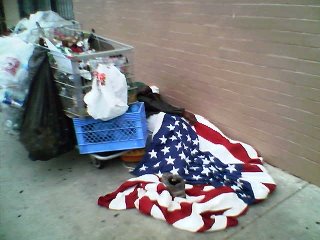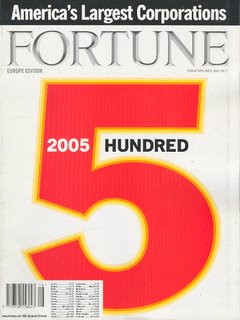
Poor Losers
How The Poor Get Dinged At Every Turn
By Clara Jeffery
From Mother Jones Magazine
2006
1 in 4 U.S. jobs pay less than a poverty-level income.
During the 1980s, 13% of Americans age 40 to 50 spent at least one year below the poverty line; by the 1990s, 36% did.
Since 2000, the number of Americans living below the poverty line at any one time has steadily risen. Now 13% of all Americans—37 million—are officially poor.
Among households worth less than $13,500, their average net worth in 2001 was $0. By 2004, it was down to –$1,400.
Bush’s tax cuts (extended until 2010) save those earning between $20,000 and $30,000 an average of $10 a year, while those earning $1 million are saved $42,700.
In 2002, Sen. Charles Grassley (R-Iowa) compared those who point out statistics such as the one above to Adolf Hitler.
Bush has dedicated $750 million to “healthy marriages” by diverting funds from social services, mostly child care.
Bush has proposed cutting housing programs for low-income people with disabilities by 50%.
Among the working poor, 13% of income is spent on commuting if public transportation is used, 21% if a private vehicle is used.
Workers who earn $45,000 or more spend 2% of their income on commuting.
2 in 3 new jobs are in the suburbs.
58% of Boston-area jobs suitable for welfare-to-work participants are within a mile of public transit.
76% of Boston welfare moms don’t own a car.
1 in 3 people who’ve left welfare since 1996 did so because they couldn’t meet program requirements or they hit the 5-year limit.
1 in 7 have no work, no spousal support, and no other government benefits.
46 million Americans are uninsured—a 15% increase since 2000.
83% of those earning $75,000 or more work for companies that offer insurance, versus 24% of those who earn less than $25,000.
51% of the uninsured are $2,000 or more in medical debt. 16% owe at least $10,000.
In 1997, 3 out of 4 doctors provided some free or reduced-cost care. Now, 2 out of 3 do.
2 in 5 elderly live on less than $18,000 a year, including Social Security benefits.
Last fall, Minnesota firefighters let an elderly man’s mobile home burn down because he hadn’t paid a $25 “fire fee.”
600,000 high school students dropped out in 2004. If each had stayed in school for just one more year, the nation would have saved $41.8 billion in lifetime health care costs.
2/3 of the reported “shrinking” gap between white and black men’s wages is attributable to black men dropping out of the labor market altogether.
The true jobless rate of black men in their 20s without a high school diploma is 72%.
A prison record reduces a convict’s wages by about 15% and wage growth by 33%.
Since 1983, college tuition has risen 115%. The maximum Pell Grant for low- and moderate-income college students has risen only 19%.
52% of poor college-qualified students go to a 4-year college within 2 years of graduating. 83% of richer qualified students do.
The Consumer Price Index for urban dwellers is up 25% since the federal minimum wage was last raised.
Inner-city grocery stores sell milk for 43% more than suburban supermarkets.
80% of food stores in Brooklyn are bodegas. Only 1 in 3 sell low-fat milk or carry fruit.
Corn subsidies have helped the price of soda fall 30% since 1983. Meanwhile, the price of fruit has risen 50%.
Per capita, the nih spends $68 on diabetes, which disproportionately affects the poor, and $1,414 on Lyme disease, which is named after a suburb in Connecticut.
63% of federal housing subsidies go to households earning more than $77,000. 18% go to households earning less than $16,500.
Since 1976, the federal budget has doubled, while hud’s budget has declined by 65%.
Initially an anti-redlining effort, sub-prime mortgages have risen tenfold since 1994.
Today, 1 in 4 sub-prime lenders are predatory, charging recipients 7% in up-front fees. Conventional or “prime” mortgage users are charged only 1%.
2% of prime mortgages carry prepayment penalties. 80% of sub-prime ones do.
Since 1986, the number of pawnshops in the U.S. has increased by 142%.
13% of U.S. households don’t have a checking account. 1 in 10 don’t have any form of bank account.
In Chicago’s poorest areas, the ratio of check-cashing outlets to banks is 10-to-1.
Check-cashing fees for a worker who brings home $18,000 a year add up to about $450 —that’s 2.5% spent just to access income.
Nationwide, the number of payday lending outlets has risen 11,000% since 1990.
The average annual interest rate on a payday loan is more than 400%, costing borrowers $3.4 billion a year.
By claiming customers are “renting” goods, rent-to-own stores avoid usury laws that require businesses to disclose and cap interest rates—commonly over 300%.
America now has twice as many publicly available gambling devices that take money—slot and video poker machines and electronic lottery outlets—as it has atms that dispense it.
Credit card late fees are 194% higher than in 1994.
The average credit card balance for households earning less than $35,000 is $4,000.
At 11.5% apr, making the standard minimum payment of 2% per month, it takes 13 years to pay off a $4,000 balance.
In 2004, 7 million working poor families spent $900 million on tax prep and check-cashing fees to get their refunds sooner.
Average amount of time by which they sped up their refunds: 2 weeks.
1 in 7 families claim the Earned Income Tax Credit, designed to lift the working poor above the poverty line.
In 2003, the irs estimated it “protected” $3.1 billion of revenue by cracking down on eitc filings. Half of all audits are now conducted on taxpayers earning less than $25,000.
41% of those making less than $30,000 think there is “a lot” of tension between the rich and the poor. Only 18% of those making $100,000 to $150,000 think this.

CEO Pay Still On Steroids
By Holly Sklar
From ZNet
2005
How would you like a 54 percent pay raise? That's how much pay jumped last year for the chief executives of the 500 largest U.S. companies, reports Forbes magazine.
Worker pay is shrinking, the economy is stalling, the trade deficit is growing and the stock market is below 1999 levels, but CEO pay is still on steroids.
The highest paid CEO in 2004 was Yahoo's Terry Semel, who hauled in $230.6 million. That's more than $4 million a week.
Yahoo is on the "Lou Dobbs Tonight" list of companies "sending American jobs overseas, or choosing to employ cheap overseas labor, instead of American workers." It would take the pay of 7,075 average American workers to match the pay of Yahoo's CEO.
William McGuire of UnitedHealth Group, the nation's leading insurer, was the third-highest paid CEO on the Forbes list. His pay of $124.8 million could cover the average health insurance premiums of nearly 34,000 people.
"While executives are richly compensated, patients are tightening their belts," Dr. Isaac Wornom, chairman of the Richmond Academy of Medicine, wrote last year. "Premiums, deductibles and co-pays are up, while benefits continue to shrink. One million Virginians -- that's one out of seven -- have no health insurance at all, and this number is increasing... Half of the uninsured work full-time for small businesses that simply can't afford the inflated rates."
CEOs can win big even when the company loses. Merck, for example, had to pull its Vioxx pain medication off the market because it increases stroke and heart attack risk, and Merck stock was down 28 percent last year, but then-CEO Ray Gilmartin got a supposedly performance-based bonus. His total 2004 compensation was $37.8 million, he received new grants of 90,000 shares of stock and 250,000 stock options, and he'll make more annually in retirement than average workers earn in their lifetimes.
CEO pay averaged $10.2 million in 2004, counting salary, bonus and other compensation such as exercised stock options and vested stock grants.
Full-time worker pay averaged just $32,594. That's 11 percent less than 1973's average worker pay of $36,629, adjusting for inflation, although worker productivity rose 78 percent between 1973 and 2004.
In 1973, CEOs made 45 times as much as workers, according to pay expert Graef Crystal. In 1991, when Crystal said the imperial CEO "is paid so much more than ordinary workers that he hasn't got the slightest clue as to how the rest of the country lives," CEOs made 140 times as much as workers. Last year, CEOs made more than 300 times as much.
Executive pay now takes more than double the bite out of company earnings it did a decade ago, report Lucian Bebchuk, Harvard Professor of Law, Economics and Finance, and Yaniv Grinstein of Cornell University's School of Management in a recent study. Looking at data for thousands of publicly traded companies, Bebchuk and Grinstein found that pay for the top five company executives rose from 4.8 percent of aggregate net company income during 1993-1995 to 10.3 percent of aggregate net income during 2001-2003.
While workers are having a tougher time making ends meet, CEOs are getting perks worth more than worker paychecks. CEO freeloaders expect perks such as lifetime use of company jets, chauffeured cars, company apartments, club memberships, sports tickets, financial planning, personal assistants and more.
In CEO World, the more money you make, the less you should have to pay for.
While worker pensions are increasingly unavailable or unreliable, CEO retirement gives new meaning to "the golden years."
CEO robber barons are increasingly stashing their loot in guaranteed pensions, deferred compensation, guaranteed consulting fees -- no actual consulting necessary -- and other postretirement perks and compensation to avoid shareholder scrutiny and sidestep the new rule for companies to treat stock options as expenses.
As Lucian Bebchuk and Jesse Fried, co-authors of "Pay Without Performance," explained in a 2004 report, "camouflaged compensation" generates less outrage, is less tied to performance and "allows executives to reap benefits at the expense of shareholders."
Making matters worse, CEOs earning more than their fair share are being rewarded with huge tax cuts.
Workers and their families are paying the biggest price as CEOs milk their companies and our country like cash cows.
Holly Sklar is co-author of "Raise the Floor: Wages and Policies That Work for All Of Us" (www.raisethefloor.org). She can be reached at hsklar@aol.com.

The Growing Power of the Fortune 500
From LRA Online
2006
President Bush’s appointment of Henry M. Paulson as Treasury Secretary cements the administration’s commitment to placing policy-making posts in the hands of the Fortune 500. Paulson, who is chairman and CEO of Goldman Sachs, has devoted his entire career to building wealth on Wall Street.
Goldman Sachs pulled in $5.6 billion in profits in 2005, up 23.6 percent from 2004, under Paulson’s aggressive management. Goldman now ranks 41st in the Fortune 500 for revenues. By assets, it is the sixth largest company in the United States.
Total revenues for the Fortune 500 hit $9.1 trillion – 73.4 percent of U.S. GDP – in 2005. The next generation may see Fortune 500 revenues surpass the total economic output of the United States.
With overseas sales added to U.S. income statements and domestic expansion still strong, the Fortune 500 have roughly doubled their economic clout in the last half century.
If the Fortune 500 constituted a nation, their economy would be the second largest in the world, and larger than the economies of Japan, the UK, Germany and France combined.
With profits of $610 billion in 2005, the Fortune 500 could purchase the entire annual economic output of South Korea, India or Brazil, or absorb the entire U.S. budget deficit for 2006 and 2007.
This hugely powerful group of companies is run by men. Only 10 of the 500 Fortune 500 CEOs are women. The situation does not change further down the scale: only 20 of the Fortune 1000 CEOs are women. Among the Fortune 100, there are no female CEOs. Fortune does not provide data on the number of minority CEOs.
The ten largest employers in the Fortune 500 employ five million workers. This group includes Wal-Mart, McDonald’s, Sears, Home Depot and Target – all low-wage retailers.
Revenues per employee are highest in the energy-related industries, but other sectors, including home building and several health care industries, generate more than $1 million a year in revenues for each employee.
Low-wage industries also generate substantial revenues per worker. Food and grocery wholesalers pulled in $637,514 per worker in 2005; beverage companies pulled in $448,812.
Industry breakdowns for the Fortune 500 help explain the health care crisis. Profits in the medical products and equipment sector jumped 45 percent in 2005. Profits for medical facilities rose 30 percent. Managed care and pharmacy companies pushed their profits up by more than 25 percent for the year. Profits for pharmaceutical companies rose 16 percent.
For the first time in the history of the Fortune 500, Texas displaced New York in 2005 as the state with the largest number of Fortune 500 companies headquartered there. Texas, a heavily Republican state with one of the lowest unionization rates in the nation, is now home to 56 of the Fortune 500.
New numbers for 2005 at Fortune 500 companies show revenues up by 10.2 percent while headcount increased only two percent. Modest employment levels and declining real wages account for much of the spectacular 18.8 percent average increase in profits for the year.
UPS, the third largest employer in the Fortune 500, increased its workforce by six percent in 2005 while revenues and profits both rose by more than 16 percent.
Home Depot, now the fifth largest employer, increased headcount six percent while revenues rose 12 percent and profits jumped 17 percent.
Citigroup, the tenth largest employer, added only 12,500 workers in 2005, an increase of just four percent, but its revenues increased 21 percent and profits ballooned by 44 percent.
This trend toward generating high revenue and profit growth with fewer employees spells softer labor markets and less leverage for workers across the United States.
A new report from McKinsey shows the same phenomenon on a global scale. The largest companies in the world ranked by market capitalization dramatically increased their share of net income while holding headcount relatively stable in the decade that stretched from 1994 to 2004.
While the Fortune 500 have regained their ability to raise revenues and profits through higher prices and wider margins, none of this new wealth has been passed along to workers.
0 Comments:
Post a Comment
<< Home